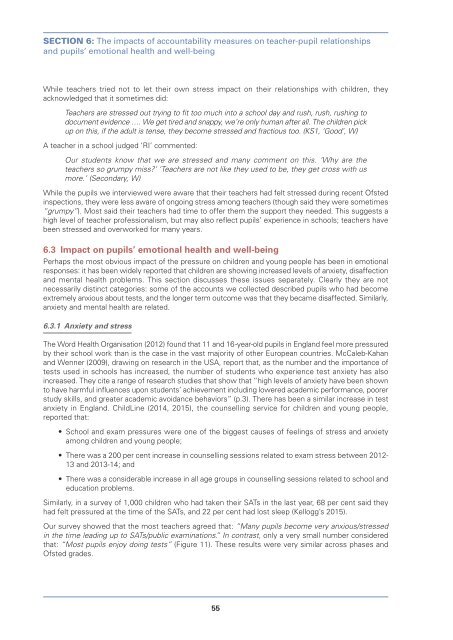exam-factories
exam-factories
exam-factories
Create successful ePaper yourself
Turn your PDF publications into a flip-book with our unique Google optimized e-Paper software.
SECTION 6: The impacts of accountability measures on teacher-pupil relationshipsand pupils’ emotional health and well-beingWhile teachers tried not to let their own stress impact on their relationships with children, theyacknowledged that it sometimes did:Teachers are stressed out trying to fit too much into a school day and rush, rush, rushing todocument evidence …. We get tired and snappy, we’re only human after all. The children pickup on this, if the adult is tense, they become stressed and fractious too. (KS1, ‘Good’, W)A teacher in a school judged ‘RI’ commented:Our students know that we are stressed and many comment on this. ‘Why are theteachers so grumpy miss?’ ‘Teachers are not like they used to be, they get cross with usmore.’ (Secondary, W)While the pupils we interviewed were aware that their teachers had felt stressed during recent Ofstedinspections, they were less aware of ongoing stress among teachers (though said they were sometimes“grumpy”). Most said their teachers had time to offer them the support they needed. This suggests ahigh level of teacher professionalism, but may also reflect pupils’ experience in schools; teachers havebeen stressed and overworked for many years.6.3 Impact on pupils’ emotional health and well-beingPerhaps the most obvious impact of the pressure on children and young people has been in emotionalresponses: it has been widely reported that children are showing increased levels of anxiety, disaffectionand mental health problems. This section discusses these issues separately. Clearly they are notnecessarily distinct categories: some of the accounts we collected described pupils who had becomeextremely anxious about tests, and the longer term outcome was that they became disaffected. Similarly,anxiety and mental health are related.6.3.1 Anxiety and stressThe Word Health Organisation (2012) found that 11 and 16-year-old pupils in England feel more pressuredby their school work than is the case in the vast majority of other European countries. McCaleb-Kahanand Wenner (2009), drawing on research in the USA, report that, as the number and the importance oftests used in schools has increased, the number of students who experience test anxiety has alsoincreased. They cite a range of research studies that show that “high levels of anxiety have been shownto have harmful influences upon students’ achievement including lowered academic performance, poorerstudy skills, and greater academic avoidance behaviors” (p.3). There has been a similar increase in testanxiety in England. ChildLine (2014, 2015), the counselling service for children and young people,reported that:• School and <strong>exam</strong> pressures were one of the biggest causes of feelings of stress and anxietyamong children and young people;• There was a 200 per cent increase in counselling sessions related to <strong>exam</strong> stress between 2012-13 and 2013-14; and• There was a considerable increase in all age groups in counselling sessions related to school andeducation problems.Similarly, in a survey of 1,000 children who had taken their SATs in the last year, 68 per cent said theyhad felt pressured at the time of the SATs, and 22 per cent had lost sleep (Kellogg’s 2015).Our survey showed that the most teachers agreed that: “Many pupils become very anxious/stressedin the time leading up to SATs/public <strong>exam</strong>inations.” In contrast, only a very small number consideredthat: “Most pupils enjoy doing tests” (Figure 11). These results were very similar across phases andOfsted grades.55


